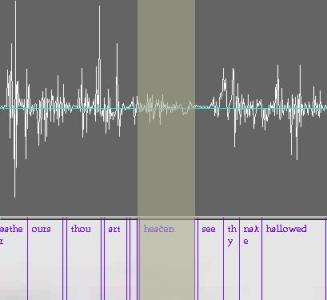
 )
you will hear the audio corresponding to the section of the sound wave that you select.
)
you will hear the audio corresponding to the section of the sound wave that you select.
The picture below shows a portion of the panel that is selected. Notice that the highlighted area is shaded. If you click the mouse again the selection is released.

Use the select and play technique to find a word that you want to annotate. Type the text in the text field at the
bottom of the sound panel and then click the add icon ( ) and the annotation
will appear. If you want to modify the text, click within the annotatation area; the current annotaion text then will display
in the text field. Modify it as you with and then click on the edit icon (
) and the annotation
will appear. If you want to modify the text, click within the annotatation area; the current annotaion text then will display
in the text field. Modify it as you with and then click on the edit icon ( ).
To delete one or more annotations, select a portion of the sound that contains the annotations you want to delete and then
click on the delete icon (
).
To delete one or more annotations, select a portion of the sound that contains the annotations you want to delete and then
click on the delete icon ( ). Using these commands will enable you to annotate the entire story
with the corresponding words that apply. This procedure is described in more detail in the
Annotation Controls page.
). Using these commands will enable you to annotate the entire story
with the corresponding words that apply. This procedure is described in more detail in the
Annotation Controls page.
 ).
).
| Recording Buttons |





|
| File Control Buttons |




|
| Edit Buttons |




|
| Recording Speed and Volume Control Buttons |



|
| Zoom Control Buttons |




|
| Selection Control Buttons |



|
| Annotation Controls |






|
| Undo and Redo |


|
 |
 | When you click the help button, this page displays. The title you gave to this lesson when it was created appears to the right of the help button |
 | All ACORNS lessons can have multiple layers; each Story Book lesson layer has separate translation. This feature can be useful to create lessons with multiple dialects. By switching between layers, the student can learn each dialects using the same lesson. The slider on the control bar enables you to set up a lesson with multiple layers. Simply click on the slider to move to the desired layer. The layer numbers are numbered as shown on the picture to the left. |
 | This control enables you to insert a background picture to the lesson. This gives you more control as to how the lesson looks when it executes. |
 | These controls allow you to control background and text colors that are used when the lesson executes. If you click either of the two left buttons, you will see a color palette display; simply click the color you want and then click OK. The button with the capital A is for the text color and the one with the three boxes and hand is for the background color. |
 | The font size drop down menu enables you to choose how big the text is when it displays while the lesson executes. Either pick a size from the selection or enter your own. |
|
The justify buttons enable you to ether center or left justify the text while the story plays. By default
the text is left justified. When you click on one of these buttons it will display depressed to indicate
that the option is active. The justification applies to a active lesson layer. | |
 | The link button allows you to connect this lesson with another lesson in the file. Clicking on this button causes a dialog window to appear. Enter the name of the lesson you want to link to. The name field is one of the header fields that you fill in when you create a lesson. (You can modify it later if you didn't.) It shows in the lesson display area on the left of the ACORNS application frame. After you click OK to the link dialog, the name of the linked lesson will show in blue on the secondary toolbar. |